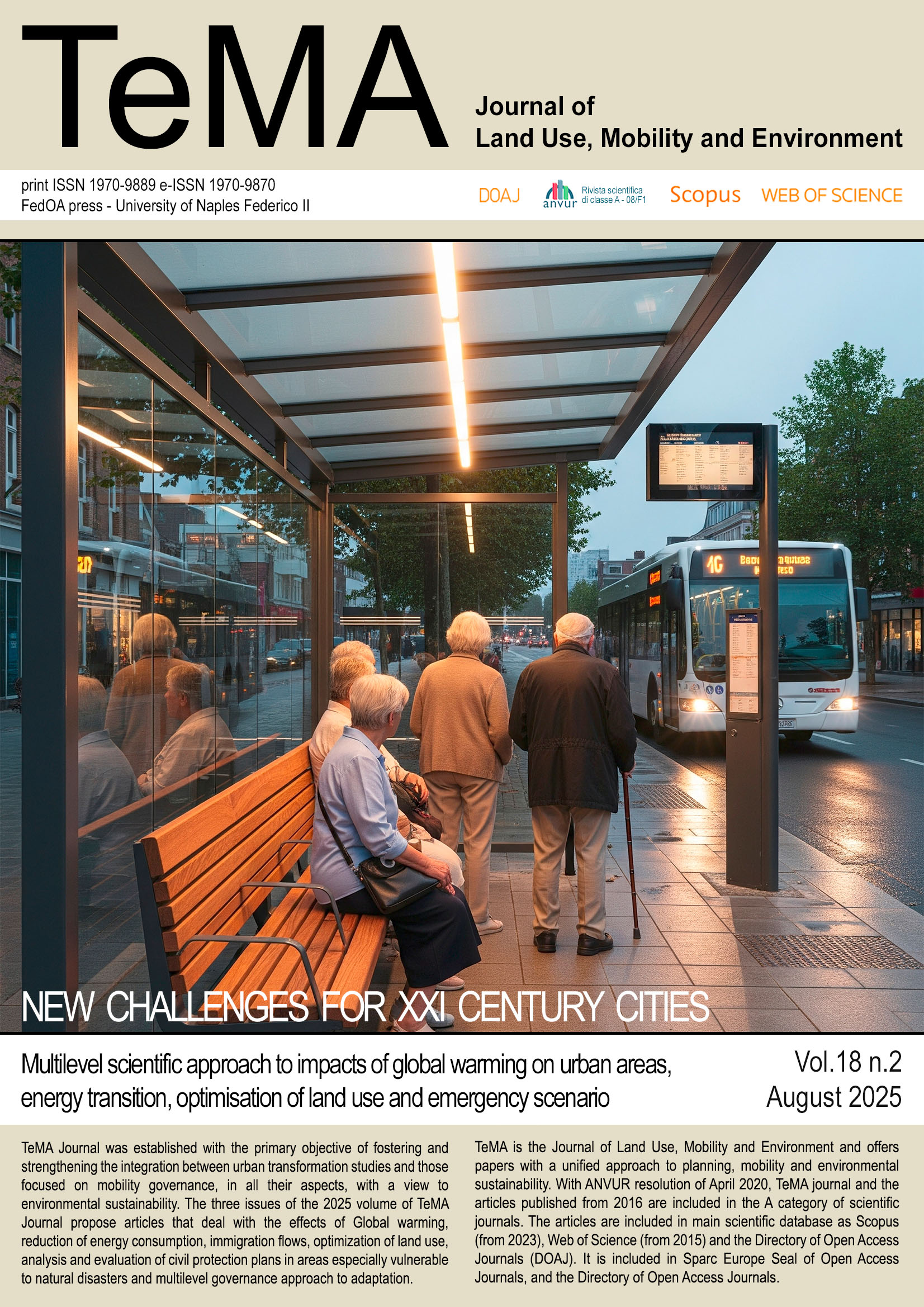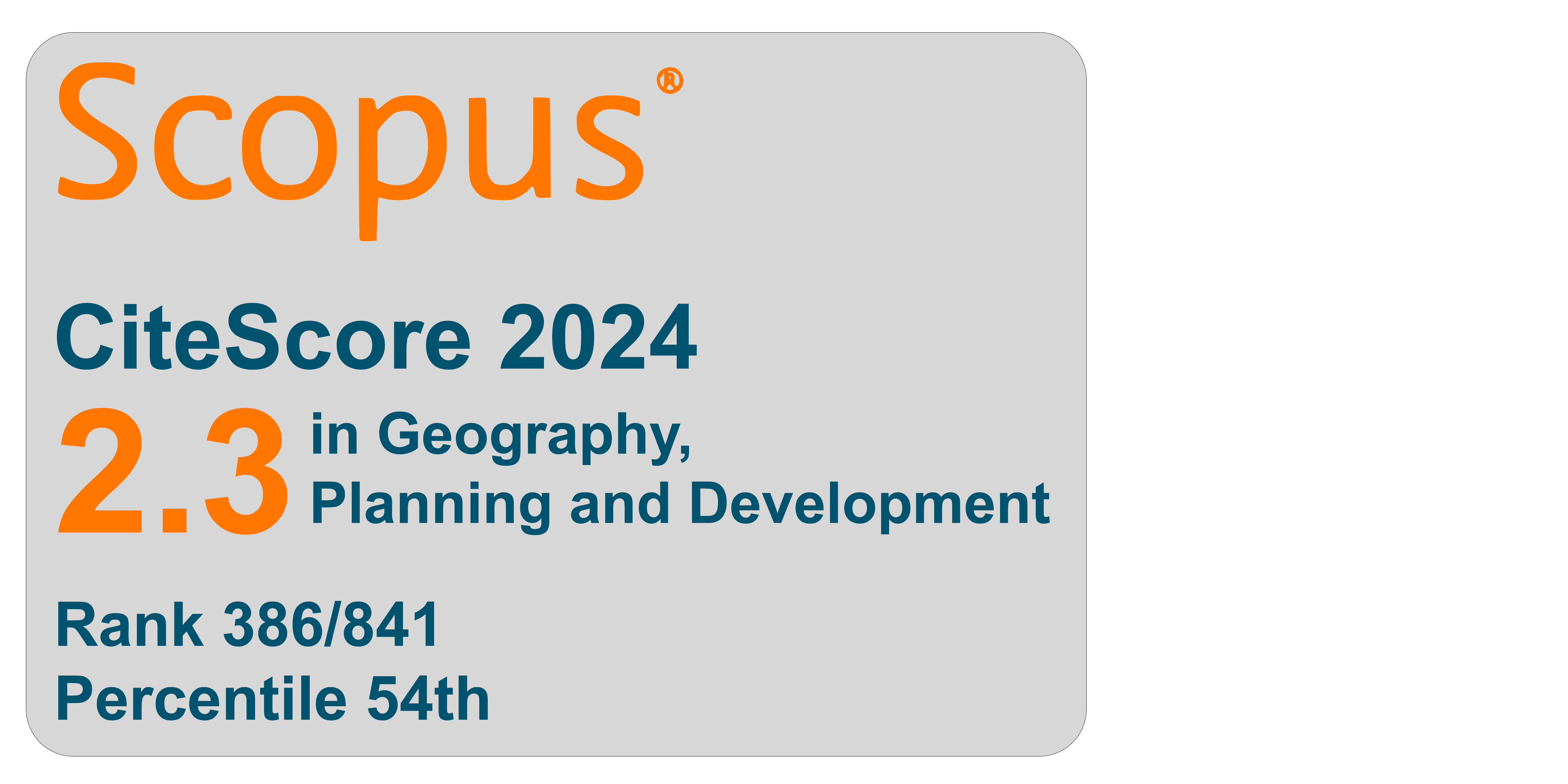An evaluation on the change of natural areas: the case of Eastern Black Sea settlements
DOI:
https://doi.org/10.6093/1970-9870/11067Keywords:
Natural areas, Land-use pattern and change, Two-step cluster analysisAbstract
Urbanization has a significant impact on social, economic and environmental sustainability. Dynamic urban development and change processes affect both the natural and built environment. Recently, with the increase in urban population and the expansion of urban areas, the pressure on natural areas has increased. Understanding the relationships between natural and built environmental elements that depend on dynamic processes is important and necessary for the future development and management of urban areas. For this reason, the study aims to analyze land use/land cover changes depending on natural environmental elements in the settlements of the Eastern Black Sea Region for a period of approximately 20 years. Considering the heterogeneous structure of the settlements, a multivariate process was followed at the district level. The data set of the study was provided by CORİNE and Two-Step Clustering Analysis was used as the method. As a result of the study, the changes over time of the districts in similar and different clusters according to their natural environment components were evaluated by comparative discussion. The results will be useful and guiding in providing input to planning decisions regarding the similarities and differences of districts-provinces and sub-regions based on natural environmental components.
Downloads
References
Addae, B., & Oppelt, N. (2019). Land-use/land-cover change analysis and urban growth modelling in the Greater Accra Metropolitan Area (GAMA), Ghana. Urban Science, 3 (1), 26. https://doi.org/10.3390/urbansci3010026
American Planning Association (2002). Growing Smart–Legislative Guidebook: Model Statutes for Planning and the Management of Change, APA’s Planners Book Service. http://www.planning.org/ guidebook/Login.asp
Bowler, D. E., Buyung-Ali, L., Knight, T. M., & Pullin, A. S. (2010). Urban greening to cool towns and cities: A systematic review of the empirical evidence. Landscape and Urban Planning, 97, 147–155. https://doi.org/10.1016/ j.landurbplan.2010.05.006
Brenner, N., Schmid, C., (2015). Towards a new epistemology of the urban? City, 19, 151–182. https://doi.org/10.1080/ 13604813.2015.1014712
Bren d’Amour, C., Reitsma, F., Baiocchi, G., Barthel, S., Güneralp, B., Erb, K.-H., Haberl, H., Creutzig, F., Seto, K.C., 2016. Future urban land expansion and implications for global croplands. Proceedings of the National Academy of Sciences. 114 (34), 8939 8944. https://doi.org/10.1073/pnas.1606036114
Bürgi, M., Hersperger, A.M., Schneeberger, N., (2004). Driving forces of landscape change current and new directions. Landscape Ecology, 19, 857–868.
Ceylan, Z., Gürsev, S. ve Bulkan, S. (2017). İki Aşamalı Kümeleme Analizi ile Bireysel Emeklilik Sektöründe Müşteri Profilinin Değerlendirilmesi. Bilişim Teknolojileri Dergisi, 10 (4), 475-485. https://doi.org/10.17671/gazibtd.323951
Chavas, J.P., (2000). Ecosystem valuation under uncertainty and irreversibility. Ecosystems, 3 (1), 11–15. https://doi.org/ 10.1007/s100210000003
Çakmak, Z., Uzgören, N., ve Keçek, G. (2005). Kümeleme Analizi Teknikleri ile İllerin Kültürel Yapılarına Göre Sınıflandırılması ve Değişimlerinin İncelenmesi. Dumlupınar Üniversitesi Sosyal Bilimler Dergisi, (12).
Daily, G. (1997). Nature’s Services: Societal Dependence on Natural Ecosystems. Island Press, Washington DC.
Douglas, O., Russell, P., & Scott, M. (2019). Positive perceptions of green and open space as predictors of neighbourhood quality of life: implications for urban planning across the city region. Journal of environmental planning and management, 62 (4), 626-646. https://doi.org/10.1080/09640568.2018.1439573
Everitt, B. (1993) Cluster Analysis for Applications. Academic Press, New York
Fahad, K. H., Hussein, S., & Dibs, H. (2020). Spatial-temporal analysis of land use and land cover change detection using remote sensing and GIS techniques. In IOP conference series: materials science and engineering 671 (1), 012046. IOP Publishing. https://doi.org/10.1088/1757-899X/671/1/012046.
Foley, J. A., DeFries, R., Asner, G. P., Barford, C., Bonan, G., Carpenter, S. R., et al. (2005). Global consequences of land use. Science, 309, 570–574. https://doi.org/10.1126/science.1111772
Gao, M., Hu, Y., & Bai, Y. (2022). Construction of ecological security pattern in national land space from the perspective of the community of life in mountain, water, forest, field, lake and grass: A case study in Guangxi Hechi, China. Ecological Indicators, 139, 108867. https://doi.org/10.1016/j.ecolind.2022.108867.
Han, B., Liu, H., Wang, R., (2015). Urban ecological security assessment for cities in the Beijing–Tianjin–Hebei metropolitan region based on fuzzy and entropy methods. Ecological Modeling, 318, 217–225. https://doi.org/10.1016/ j.ecolmodel.2014.12.015
Hapugala, G. (2013). Projecting land use transitions in the Gin Catchment, Sri Lanka. Research Journal of Environmental and Earth Sciences, 5 (8), 473-480.
He, C., Liu, Z., Tian, J., Ma, Q., 2014. Urban expansion dynamics and natural habitat loss in China: a multiscale landscape perspective. Global Change Biology, 20 (9), 2886–2902. https://doi.org/10.1111/gcb.12553
Hegazy, I. R., & Kaloop, M. R. (2015). Monitoring urban growth and land use change detection with GIS and remote sensing techniques in Daqahlia governorate Egypt. International journal of sustainable built environment, 4 (1), 117-124. https://doi.org/10.1016/j.ijsbe.2015.02.005
Herold, M., Couclelis, H., & Clarke, K. C. (2005). The role of spatial metrics in the analysis and modeling of urban land use change. Computers, environment and urban systems, 29 (4), 369-399. https://doi.org/10.1016/ j.compenvurbsys.2003.12.001
Hersperger, A.M., Bürgi, M., (2010). How do policies shape landscapes? Landscape change and its political driving forces in the Limmat Valley, Switzerland 1930-2000. Landscape Research, 35, 259–279. https://doi.org/10.1080/ 01426391003743561
Jiménez, A. A., Vilchez, F. F., González, O. N., & Flores, S. M. M. (2018). Analysis of the land use and cover changes in the metropolitan area of Tepic-Xalisco (1973–2015) through landsat images. Sustainability, 10 (6), 1860. https://doi.org/ 10.3390/su10061860
Kaiser, E., Godschalk, D., & Chapin, S. F. Jr. (1995). Urban Land Use Planning. Urbana, IL: University of Illinois, 493.
Koomen, E., Dekkers, J., & Van Dijk, T. (2008). Open-space preservation in the Netherlands: Planning, practice and prospects. Land use policy, 25 (3), 361-377. https://doi.org/10.1016/j.landusepol.2007.09.004
La Greca, P., La Rosa, D., Martinico, F., & Privitera, R. (2011). Agricultural and green infrastructures: The role of non-urbanised areas for eco-sustainable planning in a metropolitan region. Environmental Pollution, 159, 2193–2202. https://doi.org/10.1016/j.envpol.2010.11.017
Lambin, E. F., Geist, H. J., & Lepers, E. (2003). Dynamics of land-use and land-cover change in tropical regions. Annual review of environment and resources, 28 (1), 205-241.
La Rosa, D., & Privitera, R. (2013). Characterization of non-urbanized areas for land-use planning of agricultural and green infrastructure in urban contexts. Landscape and Urban planning, 109 (1), 94-106. https://doi.org/10.1016/ j.landurbplan.2012.05.012
Lei, K., Pan, H., Lin, C., (2016). A landscape approach towards ecological restoration and sustainable development of mining areas. Ecological Engineering, 90, 320–325. https://doi.org/10.1016/j.ecoleng.2016.01.080
Magliocca, N.R., Rudel, T.K., Verburg, P.H., McConnell, W.J., Mertz, O., Gerstner, K., Heinimann, A., Ellis, E.C., (2015). Synthesis in land change science: methodological patterns, challenges, and guidelines. Regional Environmental Change, 15, 211–226. https://doi.org/10.1007/s10113-014-0626-8
Maruani, T., & Amit-Cohen, I. (2007). Open space planning models: A review of approaches and methods. Landscape and urban planning, 81 (1-2), 1-13. https://doi.org/10.1016/j.landurbplan.2007.01.003
Michailidou, C., Maheras, P., Arseni-Papadimititriou, A., Kolyva-Machera, F., & Anagnostopoulou, C. (2009). A study of weather types at Athens and T hessaloniki and their relationship to circulation types for the cold-wet period, part I: two-step cluster analysis. Theoretical and applied climatology, 97 (1-2), 163-177. DOI 10.1007/s00704-008-0057-x
Millennium Ecosystem Assessment. (2005). Ecosystems and Human Wellbeing: Biodiversity Synthesis. Washington, DC: World Resources Institute.
Mobaraki, O. (2023). Spatial analysis of green space use in Tabriz metropolis, Iran. TeMA - Journal of Land Use, Mobility and Environment, 55-73. https://doi.org/10.6093/1970-9870/10117
Partheepan, K., Musthafa, M. M., & Bhavan, T. (2023). Remote sensing investigation of spatiotemporal land-use changes. TeMA-Journal of Land Use, Mobility and Environment, 16 (2), 383-402. http://dx.doi.org/10.6093/1970-9870/9908
Radke, J., Andra, S., Al-Kofani, O., Roysan, B., 2005. Image change detection algorithms: a systematic survey. IEEE Transactions Image Processing, 14 (3), 291–307.
Punj, G., ve Stewart, D. W. (1983). Cluster Analysis in Marketing Research: Review and Suggestions for Application. Journal of Marketing Research, 20 (2), 134-148. https://doi.org/10.1177/002224378302000204
Rocchini, D., Perry, G. L., Salerno, M., Maccherini, S., & Chiarucci, A. (2006). Landscape change and the dynamics of open formations in a natural reserve. Landscape and urban planning, 77 (1-2), 167-177. https://doi.org/10.1016/ j.landurbplan.2005.02.008
Satish, S. M., & Bharadhwaj, S. (2010). Information search behaviour among new car buyers: A two-step cluster analysis. IIMB Management Review, 22 (1-2), 5-15. https://doi.org/10.1016/j.iimb.2010.03.005
Seto, K.C., Kaufmann, R.K. & Woodcock C.E. (2000). Landsat reveals China’s farmland reserves, but they’re vanishing fast. Nature, 406: 121.
Seto, K. C., & Fragkias, M. (2005). Quantifying spatiotemporal patterns of urban land-use change in four cities of China with time series landscape metrics. Landscape ecology, 20, 871-888. DOI 10.1007/s10980-005-5238-8
Seto, K.C., Güneralp, B., Hutyra, L.R., (2012). Global forecasts of urban expansion to 2030 and direct impacts on biodiversity and carbon pools. Proceedings of Natural Academic Science, 109, 16083–16088. https://doi.org/10.1073/pnas.1211658109
Shih, M. Y., Jheng, J. W., & Lai, L. F. (2010). A Two-Step Method for Clustering Mixed Categroical and Numeric Data. Tamkang Journal o Science and Engineering, 13 (1), 11-19. https://doi.org/10.6180/jase.2010.13.1.02
Steffen W.L., Sanderson A., Tyson P.D., Jager J., Matson P.A., Moore B.III, Oldfield F., Richardson K., Schellnhuber H.J., Turner B.L. and Wasson R.J. (eds) 2004. Global Change and the Earth System: A Planet Under Pressure. Springer Verlag, Heidelberg.
Suthakar, K., & Bui, E. N. (2008). Land use/cover changes in the war‐ravaged Jaffna Peninsula, Sri Lanka, 1984–early 2004. Singapore Journal of Tropical Geography, 29 (2), 205-220. https://doi.org/10.1111/j.1467-9493.2008.00329.x
Tatlıdil, H. (1992). Çok Değişkenli İstatistiksel Analiz. Ankara: Hacettepe Üniversitesi Yayınları
Tekin, B. (2018). Ward, K-Ortalamalar ve İki Adımlı Kümeleme Analizi Yöntemleri ile Finansal Göstergeler Temelinde Hisse Senedi Tercihi. Balıkesir Üniversitesi Sosyal Bilimler Enstitüsü Dergisi, 21 (40), 401-436. https://doi.org/10.31795/ baunsobed.492464
Turner II, B.L., Janetos, A.C., Verburg, P.H., Murray, A.T., 2013. Land system architecture: using land systems to adapt and mitigate global environmental change. Global Environmental Change, 23, 395–397. https://doi.org/10.1016/ j.gloenvcha.2012.12.009
TÜİK (2023). Available at: https://biruni.tuik.gov.tr/medas/?kn=95&locale=tr
United Nations, (2009). World Urbanization Prospects, File 3: Urban Population by Major Area, Region and Country 1950–2050. United Nations, Department of Economic and Social Affairs, Population Division.
URL-1. https://corine.tarimorman.gov.tr/corineportal/nedir.html. (Accessed: March 2024).
Verburg, P.H., Crossman, N., Ellis, E.C., Heinimann, A., Hostert, P., Mertz, O., Nagendra, H., Sikor, T., Erb, K.-H., Golubiewski, N., Grau, R., Grove, M., Konaté, S., Meyfroidt, P., Parker, D.C., Chowdhury, R.R., Shibata, H., Thomson, A., Zhen, L., (2015). Land system science and sustainable development of the earth system: a global land project perspective. https://doi.org/10.1016/j.ancene.2015.09.004
Vincze, M., & Mezei, E. (2011). The İncrease of Rural Development Measures Efficiency at the Micro-Regions Level by Cluster Analysis. A Romanian Case Study. Eastern Journal of European Studies, 2 (1), 13.
Wu, X., Zhan, F. B., Zhang, K., & Deng, Q. (2016). Application of a twostep cluster analysis and the Apriori algorithm to classify the deformation states of two typical colluvial landslides in the Three Gorges, China. Environmental Earth Sciences, 75 (2), 146. https://doi.org/10.1007/s12665-015-5022-2
Downloads
Published
How to Cite
Issue
Section
License
Copyright (c) 2025 Doruk Görkem Özkan, Sinem Dedeoğlu Özkan, Seda Özlü

This work is licensed under a Creative Commons Attribution-NonCommercial 4.0 International License.



